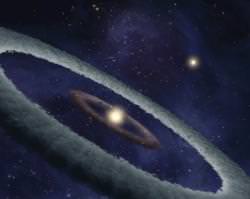Written by Fraser Cain

Astronomers believe the Earth formed out of a ring of gas and dust surrounding the Sun. Over the course of several million years, dust particles stuck together, and then collided with larger and larger chunks until all the material in the ring formed up into a single planet. The heavier elements separated from the lighter elements, and sunk down into the centre of the Earth. And if astronomers are right, it's happening all over again, in a star system 424 light-years away; another Earth is under construction.
The discovery was announced today by physicists from the Applied Physics Laboratory at Johns Hopkins University. Using data gathered by NASA's Spitzer Space Telescope, the researchers have uncovered a dust belt around a star called HD 113766. And if the theories of planetary formation are correct, this dust belt will eventually turn into a planet with roughly the mass of the Earth.
To make things even more interesting, this dust belt is located in the star's habitable zone, where liquid water could exist on any rocky planet that forms in the region.
And the timing is right too. Here's one of the researchers, Dr. Carey Lisse, "If the system was too young, its planet-forming disk would be full of gas, and it would be making gas-giant planets like Jupiter instead. If the system was too old, then dust aggregation or clumping would have already occurred and all the system's rocky planets would have already formed."
The astronomers can even tell how "processed" this material is. If it were totally unprocessed, it would be like the comets, icy remnants largely unchanged since the early Solar System. And if it was heavily processed, it would be like the asteroids, where the heavy elements have almost completely separated from the lighter elements. Instead, it's all mixed up.
The rocky planets haven't formed yet.
The paper will be published in an upcoming edition of the Astrophysical Journal.
Original Source: APL News Release



No comments:
Post a Comment